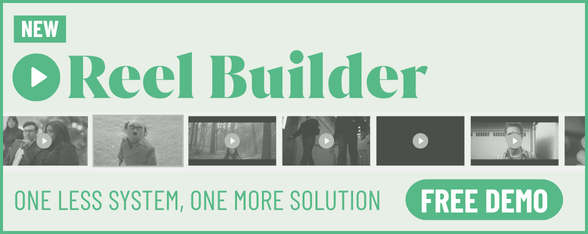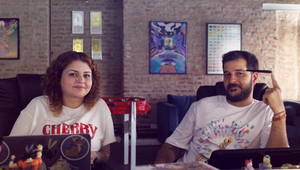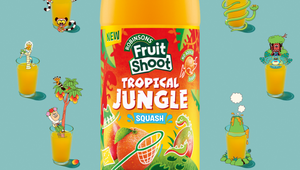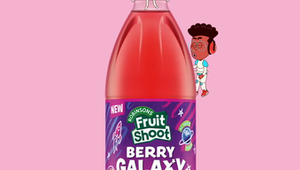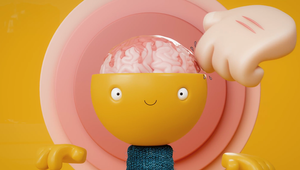
How Alex Tait Keeps His Work Warm and Human

Alex Tait brings a distinctive, instantly recognisable style that helps brands stand out. His work blends bold simplicity, clean lines, and a strong sense of relatability.
Alex creates expressive, stylised figures that breathe personality and warmth into brand storytelling. It’s this ability to make brands feel more human that has attracted the likes of Spotify, Pentagram NY, adidas, Hyundai, Humantold and Google to collaborate with him on global projects.
Dynamic and full of humour, his illustrations are more than just visually engaging - they elevate brand messaging, enhance storytelling, and create lasting impressions.
LBB> How would you describe the work that you do?
Alex> I make bold and colourful illustrations that tell stories and help brands stand out. My work often features irreverent characters in contorted poses, crowd scenes and pets. There is a tongue-in-cheek element to the nature of my work. I like to pose characters in a way that is exaggerated and playful - yet making them relatable and familiar.

LBB> And do you have a particular style (or styles) that you like to work in? If so, how would you describe that?
Alex> Simple yet busy. I like to think of each image as a composition of shapes. By breaking things down this way it helps me understand what I am drawing and lets me work in imperfection and naivety which I feel gives it a human touch and makes it feel less ‘vector’.
I try to limit things such as texture and detail, trying to use just enough when necessary to give it depth and warmth. I think a lot of brands now are after that authenticity - feeling more human and relatable - and I aim to add narrative depth that helps people connect with a location, journey, or concept in a meaningful way.

LBB> How did you gravitate towards the particular medium you work in?
Alex> Originally, I worked in pen and ink. This was before I had considered working in the illustration world, so it didn’t need to be practical.
During my time at university I spent my first two and a half years of the course focusing on graphic design. I thought it would be nice to see if I could use some of the skills I had picked up from this time to approach illustration in a different way.
I moved away from high detail intricate drawings to simple, graphic imagery and immediately fell in love with the immediacy of it.

LBB> And when you started developing your creative skills and styles, what were your inspirations and influences?
Alex> My influences were scattered across the board. I always loved the work of Tomi Ungerer, which influenced my early illustrations. He had such humour in his work and was a brilliant craftsman. I appreciated his ability to work across such a wide spectrum, from political art, to children's books… and erotica.
I never really grew out of childhood cartoons either, so naturally that would have fed into my work. Most of what I was nerding out over at the time, however, was independent publications with a heavy design focus. Things such as Slanted, Apartmento and journals of that sort. The first illustration project I worked on was a set of graphic prints of cryptids. The was a segue from design to illustration.

LBB> How has your style evolved over time - and can you talk to us about some of the stylistic experiments or avenues you’ve explored over the years?
Alex> When I first started out it was all over the shop. Having only worked on a select few projects, I still hadn’t found my footing when it came to how I approached image making.
Over time I began to set rules for myself and this began to make the process easier and give it a level of consistency. These were never really conscious undertakings, but something that I would create when looking back over old images and deciding what I liked and disliked about them.
Every time I have adjusted my style since, it has come from pushing a different aspect of different work a bit further. Be that exaggerating poses to be more extreme, limiting textures or experimenting with different things like 3D or animation.

LBB> And was there any one particular moment or project that really crystallised your understanding of what your style is or should be? If so, can you tell us about it?
Alex> Often it is about what I don’t want it to be. You can see it quite quickly when working whether it has the right ‘feel’ to it.
Fundamentally I want my work to be fun and dynamic, achieving this in the simplest way possible whilst keeping it feeling warm and human.
Reflecting on the briefs I’ve worked on over the years, you get an understanding of where your work fits. It needs to be warm and relatable.
I’ve learned I can change things stylistically and it still feels like mine, but the core of it needs to bring a smile to people when they see it.

LBB> What sort of ideas shape your style today?
Alex> I really enjoy making the more simple images currently. Working out how to get the shapes and balance just right feels rewarding and I really enjoy the graphic nature of them. I don’t think things need to be super detailed to be effective. Sometimes it’s the simplest ideas and executions that cut through.

LBB> From NFTs to the metaverse, there are more spaces for your work to show up - what are your thoughts on the impact, challenges and opportunities brought up by these new spaces? And do they influence how you think about your style (ie. is there pressure to adapt or change your style to fit these new digital frontiers - or is it kind of exciting?)
Alex> Back in their infancy, they had a lot to offer. They allowed a platform for artists to share work and build a community.
Unfortunately, as time has gone on, I think that they have begun to do more harm than good in many ways. With certain content being favoured, it has pushed artists to present their work in ways that they otherwise wouldn’t have done or felt comfortable doing.
A big part of the problem is how essential these channels have become - Instagram really seems like an essential outlet for artists to have, and so you are at the mercy of their choices.

LBB> Working in the commercial sphere, is it more important for an artist to have a distinct brand or style? What’s the balance between having a distinctive voice and being able to accommodate the visual language of the brand/campaign?
Alex> I can only speak from my own experience here but having a specific style can be very helpful.
Not just in being commissioned but also having confidence when you are. Knowing a client has come to you to create work in the style you do means that you can hit the ground running. I also get a lot of enjoyment looking over past work and seeing your own world come together visually.
As well as a visual style, the tone of voice is important. Equal to visual style, I find brands often want to apply the playful, personable and familiar tone of voice I bring as an illustrator.

LBB> Typically, on a commercial project, how do you like to tackle a brief?
Alex> I usually like to sit with the brief for as long as possible to let ideas form and just think: Who is the brand trying to communicate with? Why have I been chosen for the brief?
Whilst concepting I try to understand the audience and how far an idea needs to be pushed to balance my own tone of voice with the brand’s. That can be by taking an idea and pushing it to its furthest conclusion, then reigning it in to fit with the brand’s own ethos. Sometimes the more you push it, the better.
Initially, I find holding off from sketching and just sitting with it allows for better ideas. Once I have a few to run with I will do some quick sketches on the iPad and get them to the client to make sure we are on the right track. From there I take the work into Illustrator and work it up in vector. It tends to be close to the sketch, just refined and coloured, sometimes with some added texture.

LBB> What projects have you worked on recently that you feel were a really satisfying marriage between a brand and your own style? What was it about these projects that made them really interesting to work on?
Alex> I recently created some images for Humantold, a therapy app in the States.
They came to me to create a series of minimal scenes, looking at funny reasons city living might drive you to therapy. The client was open to collaboration from ideas to final outcome. This particular brief allowed me to include a lot of fun concepts that I was able to push.
It was a nice balance of silly (a rat on a therapist couch) to the mundane (characters staring at brick walls out of their windows). Working out how to make each scenario land was really satisfying, some required reigning in the visuals in order for the idea to land - others I could really push them.
The project felt like it was ‘mine’ and was great to be sent images from over the subway in New York. I also worked with director duo Kitchen on it, which is always an absolute pleasure seeing how they bring my characters to life through animation.







